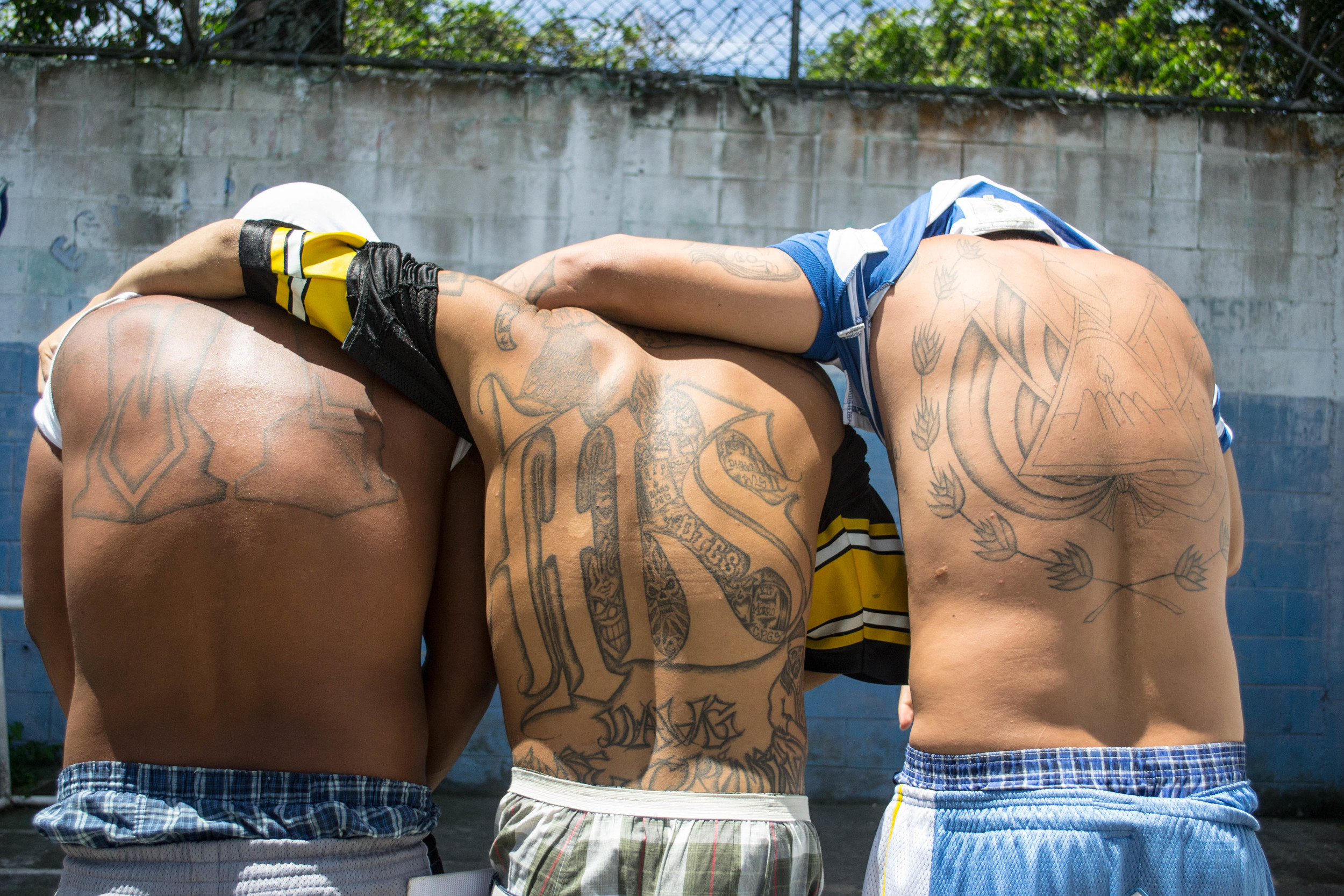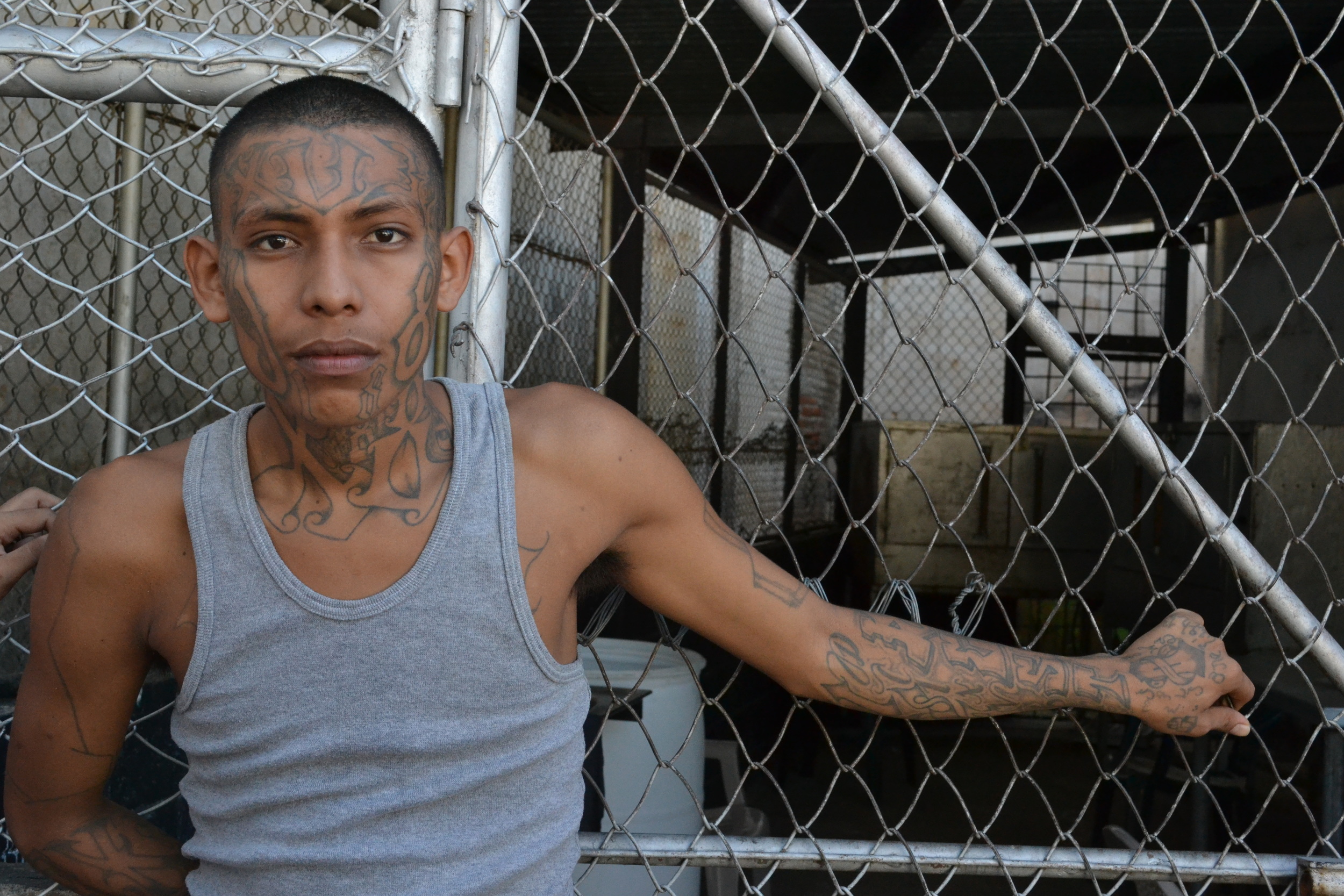WHY KIDS JOIN GANGS
As part of my research on why kids join gangs, I spent time learning from various perspectives in El Salvador. Until 2023, El Salvador was considered the murder capital of the world due to the grip gangs (MS-13 & 18 Street) had on this small Central American country. Before El Salvador’s current administration built CECOT (Centro de Confinamiento del Terrorismo, a massive prison that holds every imprisoned gang member together), I was able to meet and photograph inmates in various gang prisons around the country. After warming up to each other, many of the inmates proudly posed and held up their gang signs. At the request of the guards, some inmates are pictured with their shirts covering their faces.
In order to provide additional context and mitigate a sensationalized portrayal these gangs, I have noted a few key excerpts from USC professor and anthropologist, Tomas Ward and his book Gangsters Without Borders: An Ethnography of a Salvadoran Street Gang (Issues of Globalization: Case Studies in Contemporary Anthropology). Ward’s ethnographic study on Salvadoran street gangs spanned approximately 16 years in both Los Angeles, California and El Salvador.
Throughout my research, many people were willing to share their experiences with gangs but refused to speak on camera out of fear for their lives. I heard from parents whose children had been murdered, victims of kidnapping, terrified relatives of recently “jumped in” adolescents, and victims of home invasions and assault. I spent time with gang members both in and out of the prison system, often playing soccer and sharing meals together. I had the opportunity to have dinner with a veteran gang leader, who spent the evening revealing his bloody past and expressing remorse for the way he had lived his life. I could hear in his voice that he knew his time was running out.
Below is a clip of an interview I was able to secure with a Salvadoran police commissioner, a collection of documentary photographs, and at the bottom of this page, a short study on “Why Kids Join Gangs.”
Many of the inmates photographed in this collection are considered “hard-core” as described in following excerpt:
““During this initial stage, I conducted informal interviews with approximately eighty MS gang members from eight different cliques, or subsets of the gang. I managed to get interviews with a wide variety of gang members in order to get a sense of the diversity within the gang as a whole, within Los Angeles. Street gang members can be composed into five basic types of members or recruits: (1) wannabes, or those who are not yet members but are flirting with becoming, (2) peripheral, or those who are accepted members of the gang but are not active in crime and violence and therefore “peripheral” to gang activities, (3) core members, or those who are somewhat active, but still have lives outside the gang. (4) hard-core members, or those who dedicate their lives entirely to the gang and are the most involved in crime and violence, and (5) veterans, or those who were active but are now retired, or are still active in the gangs activities, and usually have respect within the gang.””
- “They don’t see your intellegencia, they only see your tattoos.” - Snoopy
“When I began the research for this book in 1993, like most people I had been conditioned by news, film, and television to believe this stereotype of gang members as tough “street thugs” who enjoy terrorizing others and spend most of their time selling drugs, robbing people, or doing drive-by shootings. While this is partly true for a small minority of gang members, what I found over the course of eight and a half years of fieldwork was much more complex. Although the violence and criminality of gang life have been well documented, and it is well known that some gang members are heavily involved with using and dealing drugs, what is missing from media descriptions of gang life is a holistic perspective that places this behavior in context. The media is not concerned with the fact that there is a great deal of variability of deviance between street gangs and that no two gangs are alike, Likewise, it ignores the enormous variability between individual members and the fact that most gang members are not involved in serious crimes of violence””
A Report on Why Kids Join Gangs, Finding Belonging.
The sociological phenomenon of the formation of gangs is directly related to deficient environments at home and in schools. Although abstract in definition, a gang is widely described as being involved with these four ideals: (1) a self-formed group united by mutual interests, (2) that controls a particular territory, facility, or enterprise, (3) that uses symbols in communication, and (4) that is collectively involved in crime and violence (Merrin, Hong, & Espelage, 2015). There are endless psychological and socio-environmental factors involved when trying to understand the cohesiveness of gangs and the factors that contribute to their existence. By using the results of correlative and regressive behavioral studies from "Are The Risk And Protective Factors Similar For Gang-Involved, Pressured-To-Join, And Non-Gang-Involved Youth? A Social-Ecological Analysis," and "Violence And Minority Youth: The Effects Of Risk And Asset Factors On Fighting Among African American Children And Adolescents," it is apparent that several social conditions both at home and in schools can be considered risk factors for gang involvement. Merrin, Hong, & Espelage explain that youth involvement in a gang is considered a form of maladaptation from relationships experienced in multiple environments (2015). These oppressive environments often normalize criminal activity, violence, and detached relationships, ultimately leaving kids unable to find a sense of belonging. Upon recognizing these societal conditions as contributors to the formation of gangs, anecdotal relevance of these realities can be illustrated through an analysis of individual storytelling about the lack of belonging in deficient social environments.
The home is where a child begins to form an understanding of the world and what they will consider as normal. Schooling experiences continue to hone those understandings. According to Erik Erikson’s theory of psychosocial development, as children develop through the age of eighteen, they go through pivotal stages that define their sense of trust, mistrust, self-esteem, independence, empathy, purpose, adequacy, and fidelity (McLeod, 2013). The socio-environmental factors surrounding a child during these stages are the forces that shape their sense of belonging and will contribute to the probability of their involvement in or resistance to gang activity. In both studies, students were asked to numerically represent the severity of their current exposure to gang activity and violence, as well as their experience with potentially predictive factors of gang involvement.
Several notable deficient factors from the home surfaced as a result of these correlations. In the first study, "Risk and Protective Factors," family gang involvement and dysfunction—noted as the severity of physical fighting among family members and the use of drugs and alcohol—were both highly correlated with gang association among the students. For every reported one-unit increase in both family gang involvement and family dysfunction, there was a 19.23 and 1.23 greater likelihood of gang affiliation, respectively (Merrin, Hong, & Espelage, 2015). Because gang involvement is highly correlated with violence (Wright & Fitzpatrick, 2006), risk factors for violence are inherently correlated to those of gang involvement and formation. Similarly, in the study "Violence and Minority Youth," it was apparent that several family and home factors have a close relationship with the amount and severity of violence students participate in. Significant associations in this model were with family intactness, physical abuse, family gang affiliation, and parental engagement (2006). Family intactness, parental engagement, and family gang association are factors proven to be evident risk factors for gang involvement.
Tomás Ward’s Gangsters Without Borders provides further insight into the socio-environmental factors influencing gang involvement. Ward explains that for many youths, gangs offer a sense of identity and belonging that they cannot find elsewhere. He notes, “For many young people, joining a gang is a rational decision based on the perceived need for protection, identity, and support” (Ward, 2013). This aligns with the observations of Merrin, Hong, & Espelage (2015) regarding the role of maladaptive relationships and environments in fostering gang affiliation.
The deficiencies in school environments are mainly associated with a student’s perception of school. This perception is built upon several areas including safety, a sense of belonging, availability of mentors, and the importance of education. Each factor has fluctuating correlations to gang activity based on the variance and severity of associated environmental deficiencies at home. Wright and Fitzpatrick’s study says, “Receiving personal attention from teachers, academic club membership, and being happy with school were correlated with less frequent fighting.” Similarly, receiving higher grades is also associated with less violent behaviors (2006). In the "Risk and Protective Factors" study, it was found that youth who perceived fair treatment from teachers, had a mentor figure present, and felt they belonged in school were 1.75, 1.34, and 2.01 times less likely to be involved in gangs, respectively (2015).
Ward's work also highlights the role of school environments in either exacerbating or mitigating the risks of gang involvement. He states, “Schools that fail to provide a safe, supportive, and engaging environment are more likely to see their students turn to gangs for the structure and sense of community they lack” (Ward, 2013).
The true realities of these deficiencies at home and school can be seen through the stories of those who have lived it. In his album, Good Kid, m.A.A.d City, Kendrick Lamar illustrates his childhood and the experiences he had while subject to similar conditions as those described in the studies. Kendrick grew up in Compton, California, and has since used his talents as a rapper to produce racially and politically charged music to express the realities of those socio-environmental deficiencies. There are many lines in this album that deserve to be analyzed and accounted for, but in an effort to tie similarities to Kendrick with the subjects in the studies, the lyrics in his song “m.A.A.d City” were used. Kendrick writes, “That was back when I was nine, Joey packed a nine. Pakistan on every porch is fine, we adapt to crime,” describing that in his critical developmental years, Lamar was normalizing a life of violence and crime. He continues, “AKs, ARs, ‘aye y’all duck.’ That’s what momma said when we was eatin’ that free lunch.” A reference to the free lunch programs in school, Kendrick was constantly coping with the dangerous and economic realities of his neighborhood. Lack of school funding and low family income levels are two highly contributive factors to the previously mentioned deficiencies in schools and at home, situations that both the subjects in the studies and Kendrick were faced with. The lines, “When you hop on that trolley, make sure your colors correct,” and “I made allegiance. That made a promise to see you bleeding” describe the nature of gang life as a place for both physical protection and a refuge for troubled emotions. The subjects in the studies joined gangs for protection during school and on the streets. Both they and Kendrick felt they needed to represent a gang to survive in their neighborhoods. The album title acronym "m.A.A.d" stands for both “My Angry Adolescence Divide” and “My Angel’s on Angel Dust” (Fitzgerald, 2012), representing the struggle associated with feelings of not belonging and a time when he came close to death when unknowingly smoking marijuana laced with PCP. This again reiterates the cause-and-effect relationship of these raw, unforgiving, complex, and cyclical deficiencies that shaped both Lamar and the subjects in the studies.
Due to exposure to deficient environments at home and in school, the formation of gangs continues. Through the studies "Risk and Protective Factors" and "Violence and Minority Youth," and the stories told in Good Kid, m.A.A.d City, it is apparent that there are several risk factors associated with the phenomena of gangs. Exposure to family gang involvement, dysfunction, and school perception are highly correlated factors for adolescents joining and forming gangs (Ward, 2013).
Sources
Fitzgerald, J. (2012). "Kendrick Lamar’s Good Kid, m.A.A.d City Explored." Complex.
McLeod, S. (2013). "Erik Erikson's Stages of Psychosocial Development." Simply Psychology.
Merrin, G. J., Hong, J. S., & Espelage, D. L. (2015). "Are The Risk And Protective Factors Similar For Gang-Involved, Pressured-To-Join, And Non-Gang-Involved Youth? A Social-Ecological Analysis." Journal of Youth and Adolescence.
Wright, J. P., & Fitzpatrick, K. M. (2006). "Violence and Minority Youth: The Effects of Risk and Asset Factors on Fighting Among African American Children and Adolescents." Adolescence.
Ward, T. (2013). Gangsters Without Borders: An Ethnography of a Salvadoran Street Gang. Oxford University Press.































